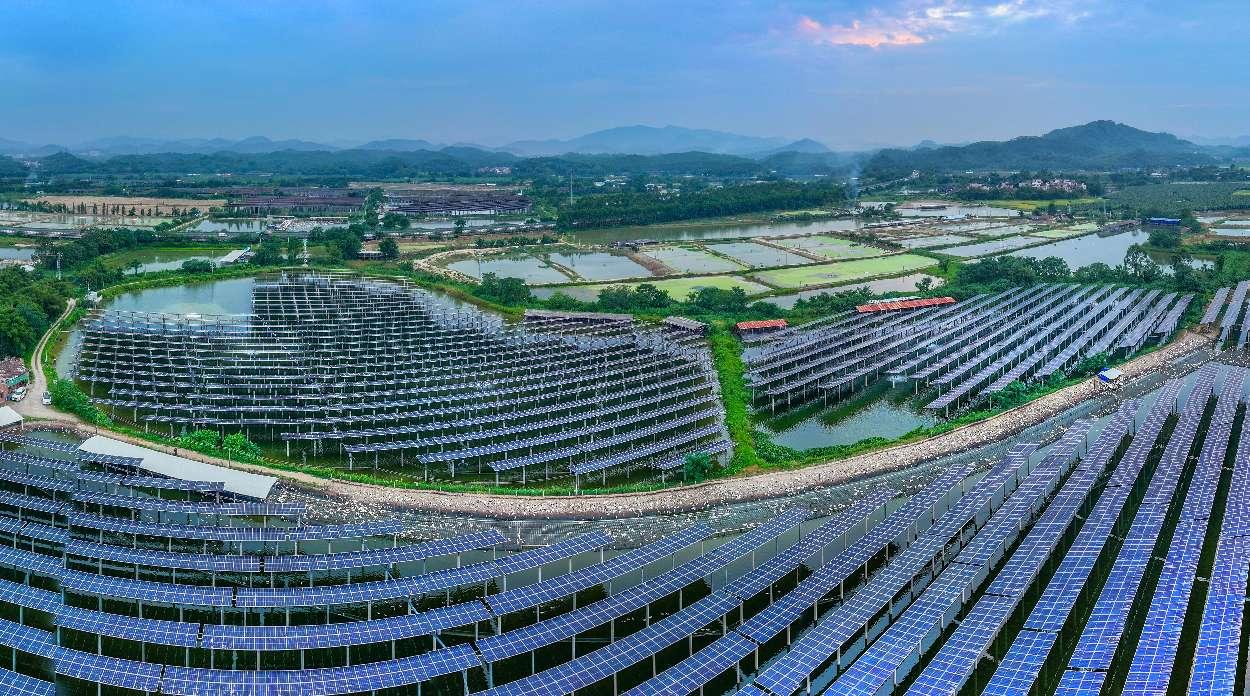Foreign
Wuhan startup rides e-commerce boom to reach global markets

By Wu Jun, People’s Daily
As more Chinese enterprises set their sights on international expansion, Hu Baoming is positioning his firm to seize the moment.
Hu heads Wuhan Gani Technology Co., Ltd., a professional window film manufacturer based in Wuhan, central China’s Hubei province. Following a recent trip to Saudi Arabia – where he finalized brand registration and compliance procedures for the company – Hu returned to China without pause. Within days, he was back to work, focused on establishing international logistics networks and overseas warehousing channels to connect Hubei with the Middle East.
As the company has scaled up production and enhanced product quality, Hu has become more determined to ride the wave of cross-border e-commerce into global markets.
“Summer is coming, and the Middle East will only get hotter,” he said, “There’s going to be strong demand for our products, especially the films that block UV rays and reduce heat.”
Among the company’s offerings, one heat-insulating film has already found a foothold overseas. This year, Hu plans to ramp up efforts in the region, doubling down on what he sees as a promising and fast-growing market.
For Chinese companies, particularly small and medium-sized enterprises (SMEs), cracking global markets has not always been easy. Establishing a physical presence, running marketing campaigns, navigating logistics and warehousing, handling cross-border payments, and staying compliant with local tax regulations can quickly overwhelm smaller players with limited international experience.
“For us, it really was starting from scratch,” Hu recalled.
Support came from the Yangtze International Trade Cross-Border E-commerce Industrial Park in Wuhan. The park connected Hu with a wide range of cross-border service providers and offered a comprehensive suite of professional solutions for going global. In the first half of 2024, Gani launched its first overseas online storefront.
Wuhan, a key foreign trade city in China, has seen its international commerce surge. According to Wuhan customs, the city recorded total imports and exports of 94.97 billion yuan ($13.01 billion) in the first quarter of 2024, up 17.8 percent year on year, driven in part by new growth in emerging markets.
To capitalize on this momentum, local authorities launched the Wuhan International Trade Digital Platform in 2024. Run by Wuhan Yangtze Trading Group Co., Ltd. under Wuhan Financial Holdings (Group), the platform aims to streamline the internationalization process for local businesses.
“We’ve rolled out over 80 trade services so far, serving more than 1,500 foreign trade companies and incubating over 140 new exporters,” said Li Shangsong, head of the platform’s project team.
The shift from offline to online services has made global expansion far more accessible for companies like Gani. “The platform offers a one-click store setup,” Hu said. “Once we fill out the required information online, we’re immediately connected with official onboarding teams from Amazon, eBay, and other leading international e-commerce platforms.”
But choosing the right market remains a critical question for many exporters. “We’ve integrated global trade data so that companies can access real-time sales trends and risk alerts across 98 major product categories before entering a new market,” Li said.
The platform now houses 2 billion trade records, covering 200 countries and regions and 600 ports. With this trove of information, businesses can fine-tune their strategies on the fly and quickly identify high-potential markets.
Once the market is selected and the stores are active, the next hurdle is getting products into customers’ hands – which means coordinating logistics and managing overseas warehousing.
According to Li, to streamline the process, the platform now works with a range of logistics service providers, allowing businesses to place shipping orders directly through the system. For sea freight, it collaborates with China COSCO Shipping Corporation Limited, giving users access to shipment tracking, schedules, and a one-stop international logistics system with real-time updates on order status.
Armed with these tools, Gani is moving forward with renewed confidence. “We’ve already launched our businesses on 12 major international e-commerce platforms and operate more than 30 online stores,” said Hu.
Still, new markets bring new challenges. “Even a great product won’t sell if nobody knows about it,” Hu admitted. While he initially considered purchasing overseas advertisements, the high costs and uncertain returns gave him pause.
To bridge the gap, the platform introduced an AI-powered marketing tool, said Li. By entering a product name and a few keywords, businesses can automatically generate multilingual marketing emails, social media copy, and product listings tailored for e-commerce platforms – all with a single click. The technology has dramatically lowered the cost of reaching international consumers.
With more targeted outreach and sharper messaging, Gani has steadily built its visibility abroad. Last year, the company reported $8 million in its sales – a number Hu hopes will continue to rise as Gani deepens its international footprint.
Foreign
Decoding China’s breakthroughs in scientific, technological innovation

By Huan Yuping, People’s Daily
Amid mounting U.S. tariffs and escalating technological suppression, global attention has shifted to China’s scientific and technological innovation – a key sector that reflects the resilience and potential of the Chinese economy.
Major international institutions have acknowledgedthat China is forging new competitive advantages through innovation, which has effectively countered protectionist shocks and injected stability into global scientific and technological development.
China’s cutting-edge breakthroughs in science and technology are making frequent headlines. The Chang’e-6 probe marked a historic milestone in human history by bringing back the world’s first samples collected from the moon’s far side. The superconducting quantum computer prototype “Zuchongzhi 3.0” set a new record in “quantum supremacy” within superconducting systems. Meanwhile, the emergence of the DeepSeek model has reshaped the global artificial intelligence (AI) landscape. These developments reflect an accelerating pace of China’s homegrown innovation.
China’s ascent in the Global Innovation Index (GII) has been both steady and striking – rising from 34th in 2012 to 14th in 2019, and reaching 11th in 2024 – making it one of the fastest risers over the past decade. This upward trajectory reflects not just sporadic breakthroughs, but the emergence of a comprehensive and sustained innovation dynamic.
The momentum driving China’s innovation makes one thing abundantly clear: efforts to stifle China’s scientific progress have not only failed, but will continue to do so. As observed by the German business news magazine WirtschaftsWoche, U.S. attempts to impose technological restrictions have proven ineffective, inadvertently spurring China to push forward.
The lack of strong innovation capability was once considered the “Achilles’ heel” of the Chinese economy. But how did China transform this former weakness into a new source of strength?
The answer begins with top-level strategic planning.
China’s spending in research and development (R&D) has maintained rapid growth, with the total R&D expenditure exceeding 1 trillion yuan ($138.38 billion) in 2012, 2 trillion yuan in 2019, and 3.6 trillion yuan in 2024. This continuous increase reflects China’s clear prioritization of innovation, underscored by strategic positioning, coordinated planning, and targeted policy support. Through its forward-looking vision, long-term layout, and firm resolve, China has laid a solid foundation for sustained progress in innovation.
This transformation is further driven by a wave of reform that has unlocked new momentum for innovation.
China has broken through ideological and institutional barriers that once impeded scientific and technological progress. Outdated evaluation metrics, which were based solely on publications, titles, degrees, or awards, have been replaced by performance-driven mechanisms, such as open competition to select the most capable candidates.
These institutional reforms have bridged the gap between the “first kilometer” of basic research and the “last kilometer” of commercialization, turning sparks of inspiration in laboratories into tangible, real-world productive forces.
At the same time, China’s innovation surge has been fueled by the emergence of a robust innovation ecosystem.
In northeast China’s Liaoning province, located in the country’s former heavy industry heartland, innovation is experiencing a revival, with 76 national-level science and technology platforms and over 5,000 high-tech enterprises now anchoring its transformation. According to the GII 2024, China leads the world with the most science and technology clusters (26) in the top 100.
International observers have noted that China’s expansive network of tech companies, universities, and research institutions has created a comprehensive innovation ecosystem — anessential driver of the country’s innovation success.
Despite external containment, China remains firmly committed to the principle of “technology for good.” It believes that innovation should be collaborative, not competitive in a zero-sum game. It is fostering greater openness and advancing international cooperation in science and technology.
China’s space station will welcome its first foreign astronaut in the next few years, after China and Pakistan signed a cooperation agreement on the selection and training of astronauts.
British pharmaceutical giant AstraZeneca has announced an investment of $2.5 billion in Beijing to establish its sixth global strategic R&D center.
German carmaker BMW said that it will deepen its collaboration with Chinese technology partners to enhance AI applications in the automotive marketing ecosystem.
European aircraft manufacturerAirbus is closely working with its Chinese counterparts to jointly promote green transformation of the aviation industry.
As The Economistput it, China is increasingly remarked for its growing role as the world’s research-and-development laboratory. Western R&D centers in China have been re-engineered, from places to learn about the domestic market into hotbeds of innovation whose fruits can be found in products sold everywhere.
Scientific and technological innovation should serve the common good of all humanity, not just the privileged few. In that spirit, China has put forward the Global AI Governance Initiative, proposedan international science and technology cooperationinitiative, and launched the AI Capacity-Building Action Plan for Good and for All.
It has also launched an Initiative on International Cooperation in Open Science with Brazil, South Africa, and the African Union, aimed at promoting scientific and technological innovation across the Global South, and ensuring that no country is left behind.Throughout its journey in scientific and technological innovation, China has always been a collaborator and enabler.
China’s pursuit of scientific and technological advancement is not about defeating or surpassing anyone. It is about improving people’s well-being and contributing to the progress of humanity. In the face of rising unilateralism and protectionism, China remains committed to openness and cooperation, sharing the fruits of innovation with more countries, and building a brighter future for all.
Foreign
China upholds fair,inclusive AIdevelopment of world

By He Yin, People’s Daily
On May 6 local time, China and Zambia co-hosted a side event of the Group of Friends for International Cooperation on AI Capacity-Building at the UN headquarters in New York.
Themed “From Divide to Synergy: Global Cooperation Frameworks for AI Capacity-Building,” the event brought together representatives from over 70 countries, including Russia, France, Brazil, Indonesia, Pakistan, and Ethiopia, as well as international organizations such as the International Telecommunication Union and the UN Office for Digital and Emerging Technologies.
Participants held in-depth discussions on ensuring the fair and inclusive development of AI, building consensus on improving AI governance and bridging the digital divide.
As a strategic technology driving a new round of scientific and industrial revolution, AI is profoundly reshaping human lifestyles and work paradigms,unlocking unprecedented developmental opportunities and vast future potential.
However, many developing countries have yet to realize these benefits. According to the International Telecommunication Union, 2.6 billion people, about 1/3 of the global population, remainedoffline in 2024. The world now faces the dual challenges of a widening intelligent divide and digital divide. Numerous developing countries are actively seeking to seize this historic window of opportunity to participate in and benefit from the dividends of intelligent development.
AI should serve as a global public good that benefits all humanity. In the face of both opportunities and challenges arising from AI, the international community must prioritize AI for the common good,promote fairness and inclusiveness, advocate multilateral approaches, and prioritize capacity-building efforts.
In response to the concerns and aspirations of developing nations, China and Zambia jointly established the Group of Friends for International Cooperation on AI Capacity-Building. Since its inaugural meeting in December 2023, the Group has expanded steadily, emerging as a key player in global AI governance. It has injected new momentum into strengthening cooperation on AI capacity-building and narrowing the digital divide.
China is a strong advocate for the fair and inclusive development of AI. In October 2023, Chinese President Xi Jinping put forward the Global AI Governance Initiative, which proposed to increase the representation and voice of developing countries in global AI governance, and ensure equal rights, equal opportunities, and equal rules for all countries in AI development and governance. The initiative said that efforts should be made to conduct international cooperation with and provide assistance to developing countries, to bridge the gap in AI and its governance capacity.
In July 2024, China pushed for the adoption of a resolution on strengthening international cooperation in the capacity-building of AI at the 78th session of the UN General Assembly, contributing to the formation of a broad international political consensus.
At the 19th G20 Summit, Xi stressed the importance to step up international governance and cooperation on AI, to make sure that AI is for good and for all, not a game of the rich countries and the wealthy.
China is taking concrete actions to promote the fair and inclusive development of AI. In September 2024, China proposed the AI Capacity-Building Action Plan for Good and for All, laying out an international cooperation framework on key areas such as infrastructure, industrial empowerment, personnel training, digital development and security governance.
Institutions such as the China-BRICS AI Development and Cooperation Center and the China-ASEAN AI Innovation Cooperation Center have been established. China has engaged in joint technology R&D and innovation cooperation with countries such as Vietnam and Laos. Besides, Chinese enterprises are partnering with the Egyptian government on the Digital Egypt Builders Initiative, supporting the United Arab Emirates’ smart city construction, and helping Saudi Arabian enterprises improve operational efficiency.
China stands ready to engage broadly in international cooperation on AI and assist other Global South countries in strengthening their technological capabilities, thus narrowing the global intelligent divide.
China will remain steadfast in championing the fair and inclusive AI development of the world. It will continue to enhance the role of the Group of Friends for International Cooperation on AI Capacity-Building, improve cooperation mechanisms, expand cooperation areas, diversify cooperation models, and work with other developing countries to share the dividends of AI and jointly build a brighter intelligent future.
Foreign
China’s green power trading gathers momentum

By Lyu Shaogang, People’s Daily
Green power refers to electricity generated from renewable energy sources such as wind, solar, and hydropower. A “green electricity certificate (GEC)”serves as the official validation of this renewable electricity andit is the only recognized credential in China that certifies the production and consumption of green power.
Issued exclusively by China’s National Energy Administration, GECs can be obtained either through the purchase of green power or via independent trading. Each certificate is unique and, for now, can only be traded once. It includes details such as a transaction ID, buyer information, and quantity purchased. Users may scan a QR code to trace the certificate’s origin to its corresponding renewable energy project.
Each certificate represents 1,000 kWh of renewable electricity. In other words, trading a single certificate means that 1,000 kWh of green power has either been integrated into the grid or consumed.
In recent years, with the continuous expansion of China’s green power production capacity, driving a sharp rise in both green power consumption and GEC transactions. In March of this year alone, the National Energy Administration issued 174 million GECs — a 9.39-fold increase year on year. From January to March, 200 million certificates were traded nationwide.
By logging onto a “southern China green power trading system,” users can easily browse a wide variety of certificate products at the click of a button. Options include wind, solar, and biomass, among others, with transparent details on prices, inventory, and production dates. Once a user selects a project and makes a payment, the entire transaction can be completed within minutes.
Why are companies willing to buy GECs?
“Export-oriented firms, energy-intensive industries, multinational corporations, and large central or state-owned enterprises all have strong demand for green energy,” explained Huang Mei, deputy general manager of the market and customer service department at China Southern Power Grid’s Shenzhen branch. By purchasing GECs, companies can demonstrate their green power consumption, reduce carbon emissions, and build a environmentally responsible brand image.
“In 2024, we purchased around 5,000 GECs, fully offseting our annual electricity consumption of 5 million kWh,” said Guo Zhaocheng, deputy general manager of Shenzhen SDG Information Co., Ltd. in Shenzhen, south China’s Guangdong province, a company deeply engaged in data center construction and other power-intensive businesses. It began purchasing Green Certificates in June 2024.
“Participating in green electricity consumption and fulfilling our low-carbon responsibilities gives us a competitive edge in project bidding,” Guo added.
“Purchasing GECs doesn’t mean using green electricity directly. Rather, it means acquiring the environmental attribute of green power, achieving the effect of renewable energy usage,” Huang further explained. GEC trading breaks through physical limitations of power transmission, serving as a “bridge” between the production and consumption of green energy, unlocking new development opportunities.
“Downstream international clients prioritize green energy utilization. In 2024, 40 percent of our electricity consumption—more than 19.08 million kWh—came from green power,” said Zhu Huawei, procurement manager at Shenzhen Zhenghe Zhongxin Plastic Products Co., Ltd.
This year, the company has further expanded its production capacity, and related contracts specify that 85 percent of its actual power usage must be green electricity.
“Increasing green energy consumption enables us to secure more orders, enhance our brand value, strengthen global competitiveness, and promote sustainable low-carbon development,” Zhu said. This mindset is increasingly shared among many companies.
In 2024, green power transactions in Guangdong’s Guangzhou and Shenzhen reached 1.728 billion kWh, up 189 percent year on year, with 717 participating enterprises, an increase of 1,075 percent.
That same year, Shenzhen’s GEC transactionsexceeded 17 million, representing 17 billion kWh of green electricity, and the numbers continue to grow steadily. Green power and GEC are becoming increasingly popular, and the trading market continues to heat up.
The boom in green power and certificate trading is driven by enthusiasm from both supply and demand sides.
“Building renewable energy projects requires high upfront investment. The extra revenue from GEC sales gives us more incentive and confidence to keep expanding our R&D investment,” said Wang Tuo, marketing manager of CGN New Energy Holdings Co., Ltd., a Guangdong-based new energy investment company.
Take the company’s 1-million-kilowatt offshore wind power project at Huizhou Port as an example: it generates around 3 billion kWh of clean electricity for Guangdong annually, reducing standard coal consumption by 1 million tons, and cutting carbon dioxide emissions by about 2.35 million tons—equivalent to planting 6,000 hectares of trees.
By monetizing the environmental value of renewable energy through GEC trading, the market is sending positive signals for building a new energy system and boosting green power supply. In 2024, Shenzhen’s grid added 288,600 kilowatts of newly connected renewable energy capacity, a 51 percent increase year on year, and achieved full utilization of 3.123 billion kWh of renewable electricity which connected into the national grid.









